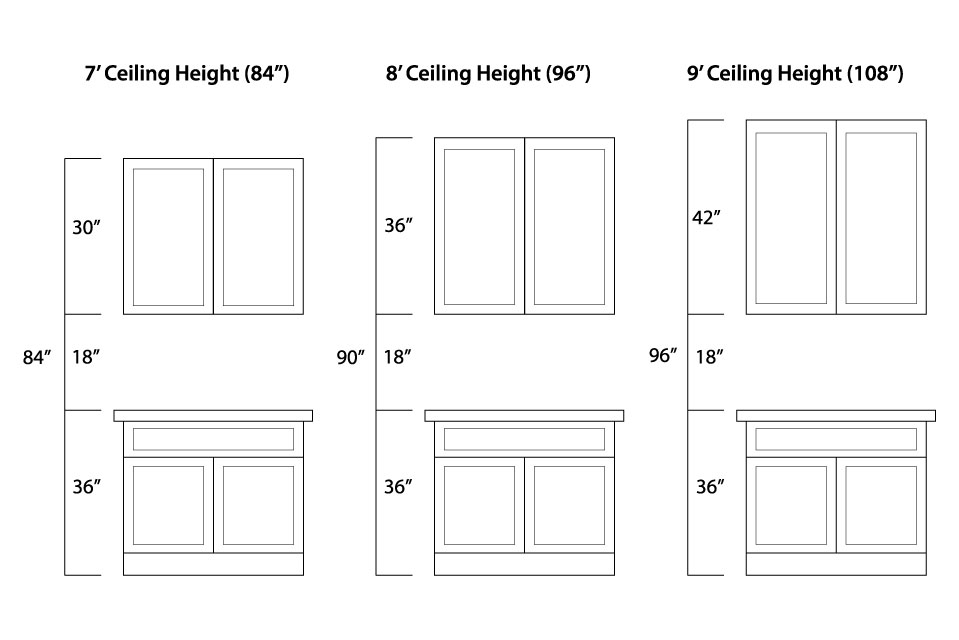Standard Height Considerations: Standard Height From Countertop To Wall Cabinet

The distance between your countertop and wall cabinets is a crucial element in kitchen design. It directly impacts the usability, functionality, and overall comfort of your kitchen. A well-designed height ensures easy access to your cabinets, reduces strain on your back and shoulders, and enhances the overall workflow of your kitchen.
Factors Influencing Ideal Height
The ideal countertop to wall cabinet height is not one-size-fits-all. Several factors influence this measurement, making it crucial to consider your individual needs and preferences.
- User Height: The primary factor influencing countertop to wall cabinet height is the user’s height. A standard height might be suitable for someone of average height, but it might be too high or too low for someone taller or shorter. Ideally, the countertop should be at a comfortable height for the primary user to reach and work comfortably.
- Accessibility: For people with mobility limitations, accessibility is paramount. A lower countertop and cabinet height can significantly improve ease of use and access for people who use wheelchairs or have limited reach.
- Ergonomics: Ergonomics plays a significant role in kitchen design. A comfortable countertop height minimizes strain on your back, neck, and shoulders, promoting good posture and reducing the risk of injuries. The ideal height allows you to reach your cabinets and work comfortably without having to bend or stretch excessively.
Impact of Different Heights
The height of your countertops and cabinets can significantly impact your comfort and functionality in the kitchen.
- High Countertop and Cabinet Height: This configuration is suitable for taller individuals. It provides ample overhead storage and can create a more spacious feel in the kitchen. However, it might be challenging for shorter individuals to reach the upper cabinets comfortably, leading to potential strain and discomfort.
- Low Countertop and Cabinet Height: This setup is ideal for shorter individuals. It provides easy access to countertops and cabinets, minimizing strain and promoting comfortable working conditions. However, lower cabinets might feel cramped and might not offer as much storage space as taller cabinets.
Practical Applications and Design Tips

The standard countertop to wall cabinet height is a crucial element in kitchen design, affecting functionality, accessibility, and aesthetics. Understanding the practical applications and design tips for adjusting this height can significantly enhance the overall kitchen experience.
Countertop and Cabinet Heights for Different User Heights and Tasks
The optimal countertop and cabinet heights can vary based on user height and the intended tasks. Here’s a table outlining common heights and their suitability for different users and tasks:
| User Height | Countertop Height | Cabinet Height | Suitable Tasks |
|---|---|---|---|
| 5’0″ – 5’4″ | 34″ – 35″ | 30″ – 32″ | General food preparation, light cooking, serving |
| 5’4″ – 5’8″ | 36″ – 37″ | 32″ – 34″ | Most common tasks, including chopping, mixing, and baking |
| 5’8″ – 6’0″ | 38″ – 39″ | 34″ – 36″ | More demanding tasks, such as heavy lifting and rolling dough |
| 6’0″ and above | 40″ – 42″ | 36″ – 38″ | Specialized tasks, requiring extra clearance and reach |
Adjusting Standard Height for Specific Needs, Standard height from countertop to wall cabinet
Adjusting the standard countertop and cabinet height can significantly enhance accessibility and comfort for individuals with specific needs. For instance, lowering the countertop height to 32″ – 34″ can make it easier for wheelchair users to reach and work comfortably. Similarly, raising the height to 40″ – 42″ can accommodate taller individuals, providing them with better ergonomics and reducing strain on their backs and necks.
Incorporating Different Cabinet Types
Beyond adjusting the standard height, incorporating different cabinet types can further enhance kitchen functionality and aesthetics.
Upper Cabinets
Upper cabinets provide valuable storage space, keeping items out of reach while maintaining visual appeal. They are commonly placed above countertops, with a standard height of 18″ – 24″ from the countertop. Consider installing upper cabinets with glass doors to showcase decorative items and create a sense of openness.
Wall Shelves
Wall shelves offer a more flexible storage solution compared to upper cabinets, allowing for customized arrangements based on the size and shape of the items being stored. They are typically placed at a height that is comfortable to reach, often above the countertop or even at eye level.
Open Shelving
Open shelving provides a modern and visually appealing alternative to traditional cabinets, showcasing dishes, cookware, and decorative items. They can be placed at various heights, depending on the intended use and the overall kitchen design.
Yo, so you’re thinking about that standard height from countertop to wall cabinet, right? It’s all about finding that sweet spot for functionality and comfort. And when you’re working with maple cabinets, you gotta think about the countertop vibe too! Check out this guide on countertops that go with maple cabinets to get some inspiration.
Once you’ve got your countertop game on point, you’ll be rocking that perfect height from countertop to wall cabinet in no time.
Yo, you know that standard countertop to wall cabinet height? It’s like the foundation of any good kitchen. But, don’t forget about the vibes! Adding some black and white bedroom wall decor can totally elevate the whole space. And hey, even with all the cool decor, remember to keep that countertop height consistent.
It’s all about balance, ya know?